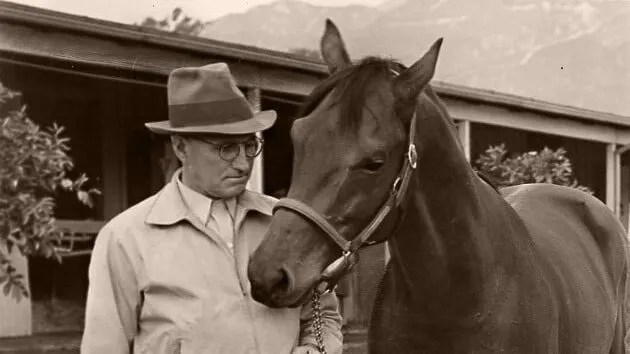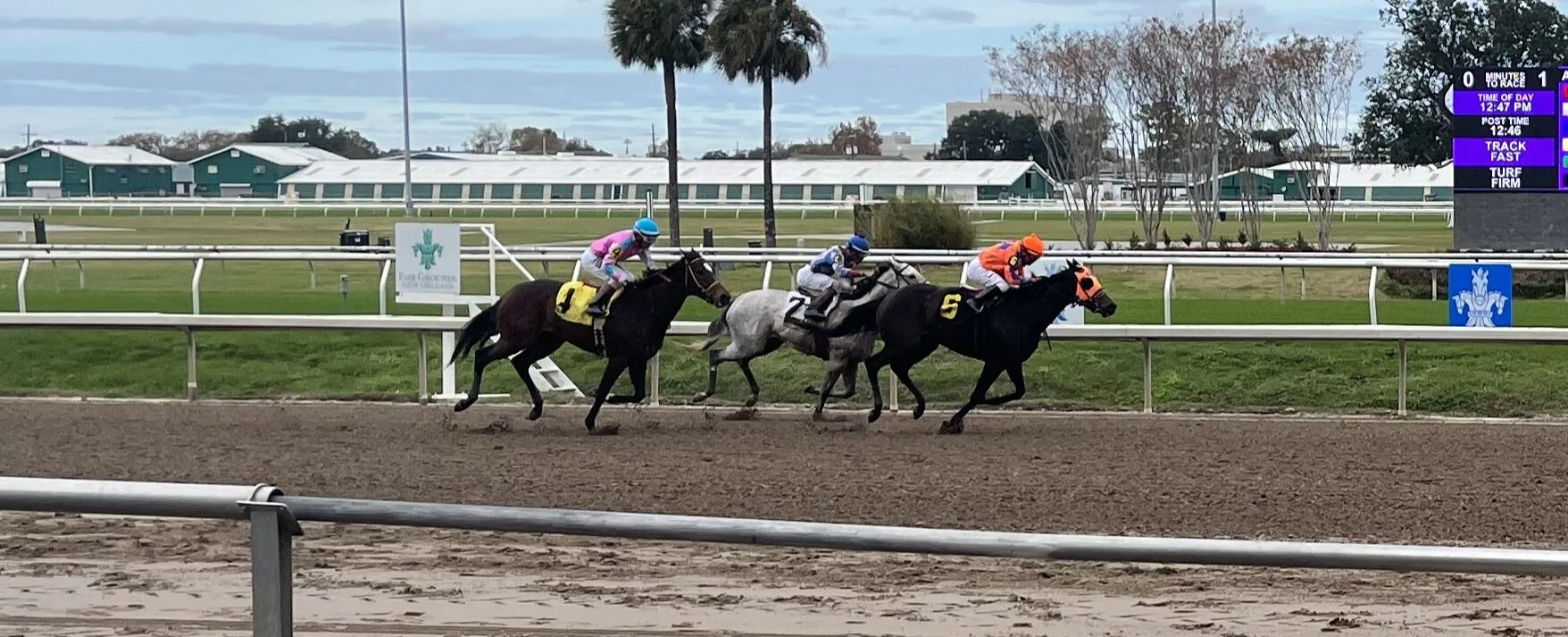Last updated: April 17, 2024
Claiming races are a special kind of horse race where any horse running can be bought at a fixed price before the race starts. This format makes these races both fun and somewhat unpredictable.
Claiming races level the playing field and demand strategic thinking from horse owners and trainers. In this article, I will explain why claiming races are important and how they make horse racing more exciting.

Defining Claiming Races
Claiming races bring a unique blend of strategy and excitement to horse racing. Here’s a closer look at what makes these races special:
Definition and Basic Concept:
- What It Is: A claiming race is where every horse running has a price tag. Before the race begins, any registered buyer can purchase a horse at this set price.
- The Twist: While buyers can claim any horse, the original owner retains any prize money the horse earns in that race. This setup creates a thrilling gamble where owners weigh the risk of losing their horse against the potential earnings from a win.
Historical Context:
- Origins: Claiming races have deep roots, dating back centuries. They were created to ensure that horses of similar abilities compete against each other, which helps keep races fair and competitive.
- Purpose: These races were introduced to prevent mismatches in competitions, ensuring that every race is a close contest where each horse has a genuine chance to win based on ability rather than simply having superior horses dominate.
Role in Horse Racing:
- Leveling the Playing Field: By pricing horses and allowing them to be claimed, these races ensure that all entries have a similar chance of winning, making the outcomes more unpredictable and exciting.
- Dynamic Marketplace: Claiming races serve as active markets for buying and selling racehorses, vitalizing the horse racing industry by allowing for frequent ownership changes.
- Strategic Gameplay: Trainers and owners must balance risk and reward by setting the right claiming price. They must decide on the best price to maximize potential earnings without sacrificing a valuable horse.
Claiming races add strategic depth and excitement to horse racing, helping fans and newcomers understand and enjoy the sport more.

Claiming Races: The Process
Claiming races might seem straightforward, but they involve many important details behind the scenes. Here’s a step-by-step guide on how these races are organized and run:
1. Planning and Entry:
- Race Listings: Race directors or track authorities outline the conditions for claiming races, detailed in condition books accessible to owners and trainers. These books list all upcoming races, specifying conditions and the set claiming prices.
- Deciding to Enter: Owners and trainers use these condition books to pick suitable races. They consider the horse’s current condition, performance history, and claiming price.
2. Claiming Price Range:
- Setting the Price: Claiming prices vary significantly, usually from $5,000 to over $50,000, reflecting the horse’s perceived value and competitive capabilities.
- Personal Example: I manage horses differently based on their capabilities and the competitive landscape; some compete in $5,000 claiming races, others in $15,000 to $20,000 races, and some are not entered in claiming races at all.
3. Claiming Procedure:
- Before the Race: Buyers must submit a claim slip and proof of funds before the race starts.
- During the Race: Horses run for their current owners but can be claimed by new ones during the race.
- After the Race: If a horse has more than one claim, the new owner is chosen by random draw. The original owner keeps any prize money, but the horse goes to the new owner right after the race.
A Strategic Move with Mixed Outcomes: I entered a horse in a claiming race to get an easy win and earn some money. She won, but another owner claimed her. She later won over $100,000 for her new owner. This experience shows the risks and rewards of entering horses in claiming races. Sometimes, you win a race but lose a great horse.
4. Transition to New Ownership:
- Ownership Transfer: Right after the race, all necessary registration and paperwork for the horse are transferred to the new owner.
- Veterinary Check: Generally, a veterinary exam is conducted after the race to ensure the horse is in good health before it officially changes hands.
In this YouTube video, we learn about claiming races from racehorse trainer Jay C. Nehf.
5 Strategic Benefits of Claiming Races
Claiming races are crucial for horse owners and trainers looking to strategically manage their stables. Here’s why they are a popular choice:
1. Leveling the Competition:
- Fair Play: Owners use claiming races to compete against horses of similar value, ensuring a fair race where outcomes are more predictable.
2. Stable Management:
- Quick Adjustments: These races offer a quick way to buy or sell horses, helping owners keep their stables aligned with their racing strategies without waiting for auctions.
3. Financial Strategy:
- Controlled Costs: Claiming races help owners manage budgets better, as they can plan their investments with known costs upfront, deciding which horses to buy or sell based on their financial goals.
4. Discovering Potential:
- Finding Talent: They provide a platform to acquire horses that may be undervalued or possess untapped potential, enhancing a stable’s competitive edge.
5. Balancing Risk and Reward:
- Strategic Decisions: The decision to enter a horse in a claiming race involves weighing the risk of losing a valuable asset against the potential reward of winning or finding a better-suited horse for future races.

Comparing Race Types
Understanding the different types of horse races can help owners, trainers, and fans appreciate the sport’s nuances. Here’s how claiming races stack up against other popular race types:
Claiming vs. Maiden Races: Starting Out
- Maiden Races: These races are for horses that have never won a race. They help identify promising new talent and give young horses experience in racing conditions.
- Claiming Races: Unlike maiden races, claiming races can feature horses of various experience levels. Each horse is available for purchase at a predetermined price, adding a layer of strategy regarding ownership and value.
Claiming vs. Allowance Races: What’s the Difference?
- Allowance Races: Horses in these races carry different weights based on their past performances, aimed to level the competitive field. They often feature horses that have won races but aren’t ready for stakes competition.
- Claiming Races: The primary difference is the claiming option—horses run at a price tag, and they can be claimed (purchased) by another owner before the race. It balances the field not by weight but by the market value set through claiming prices.
Claiming vs. Stakes Races: High Stakes Competition
- Stakes Races: These are high-level races with larger prize money, featuring the best horses with proven track records. Horses cannot be claimed in these races; they are entered based on their past success and earnings.
- Claiming Races: More accessible than stakes races, claiming races allow for a diverse range of horses, including those stepping up from lower levels or needing to prove their competitiveness. The stakes are generally lower, but the races are crucial for adjusting a stable’s roster effectively.

Strategies for Success in Claiming Races
Claiming a horse is not just about picking any runner in the race. It involves careful consideration, strategy, and sometimes, a bit of intuition. Drawing from my years of experience in horse racing, here are key strategies to help you make successful claims.
- Tips for Owners and Trainers Entering Horses:
- Assess the competition: Carefully evaluate the field to select the right race and claiming price for your horse.
- Condition and readiness: Ensure your horse is in peak physical condition and mentally prepared for the race.
- Race placement: Strategically choose when and where to enter your horse based on its abilities and form.
- Advice for Potential Buyers on Making Wise Claims:
- Research horses: Study the past performance, health, and potential of horses available for claiming.
- Assess risks: Consider the claiming price and the horse’s condition; weigh the potential rewards against the investment.
- Expert guidance: Consult with experienced trainers or advisors to make informed decisions.
- Understanding Risks and Rewards:
- Winning vs. losing: Recognize that claiming races involve the risk of losing your horse but offer the chance to win.
- Investment perspective: View claiming as a long-term investment in the sport, not just a single race.
- Emotional detachment: Maintain objectivity and avoid sentimental attachments when participating in claiming races.
Rising from Claiming to Allowance Races
I have a horse that started in 5,000.00 claiming races. It took him three tries to win his first race. Since that win, he’s improved so much that I only enter him in allowance races. His journey shows how a horse can progress with the right training and races.

Famous Success Stories from Claiming Races
While claiming races are often seen as a starting point, they have been the proving grounds for some of horse racing’s greatest legends. Here are a few horses whose careers took off from humble beginnings in claiming races, proving that potential champions can come from anywhere:
- Seabiscuit: This legendary horse ran in three claiming races for as low as $2,500, yet no one claimed him. Seabiscuit’s journey from an overlooked underdog to a celebrated champion is a testament to the unexpected opportunities in claiming races. Learn more about his incredible story in my detailed article, Seabiscuit: 10 Facts About An Unlikely Champion Racehorse.
- Stymie: Starting out in claiming races, Stymie was eventually claimed for just $1,500. He became one of the top 100 racehorses of all time, illustrating the hidden potential in these competitive events.
- John Henry: John Henry began his career at mid-level, claiming races, and evolved into a racing icon. He became the first racehorse to surpass $4 million in earnings. By the time he retired, his earnings had exceeded $6.5 million, highlighting how a horse from claiming races can reach the pinnacle of horse racing success.
These stories inspire and highlight the strategic importance of claiming races in discovering and developing racing talent. They remind us that every race, no matter how humble its premise, has the potential to launch a champion.

The Prices of Claiming Races Vary Greatly.
Claiming amounts vary by track; however, at the lower end, you will see claiming races as low as $2,500.00 and as much as $100,000.00.
This chart provides a glimpse of the number of horses claimed and the horses’ corresponding costs at different tracks. As you can see, claiming horses is a vibrant enterprise.
| Track | Total Claims | Total Amount | Date |
|---|---|---|---|
| Churchhill Downs | 125 | $2,233,000 | Fall/2018 |
| Santa Anita | 28 | $719.000 | 4/12/19-5/5/19 |
| Fairgrounds Race Track | 358 | $4,915,000 | 11/2018-4/2019 |
| Oaklawn Race Track | 560 | $9,114,750.00 | 1/2019-5/2019 |

FAQs (Frequently Asked Questions) About Claiming Races
What is the purpose of claiming races?
Claiming races aim to ensure fair competition in horse racing by grouping horses of similar abilities and values together. They also provide a marketplace for buying and selling racehorses.
Who can participate in claiming races?
Owners, trainers, and authorized buyers with the necessary licenses can participate in claiming races. These individuals are responsible for entering horses and making claims.
How is the claiming price determined?
Track authorities write claiming races and set the prices. Owners and trainers choose the claiming races they want to enter each horse, reflecting their assessment of the horse’s value and competitive level.
What happens if a horse is claimed in a race?
When a horse is claimed, the new owner assumes ownership immediately after the race. However, any prize money won in that race goes to the original owner.
Are claiming races a good starting point for new owners in horse racing?
Claiming races can be an accessible entry point for new owners, as they offer opportunities to acquire horses and gain experience. However, careful research and guidance are essential.
What does G3 mean in horse racing?
G3 denotes the horse race is a grade 3 stakes race. Many G3 races are open to horses that have not won a graded stakes race before, making them an important stepping stone for many young thoroughbreds.
Conclusion: What Is a Claiming Race
Claiming races play a pivotal role in the world of horse racing. These events are not just about competition; they are a strategic gateway for owners to manage their stables efficiently, offering new and seasoned horses a platform to showcase their abilities and potential.
By setting a price tag on each horse, claiming races level the playing field, making them as thrilling as they are tactical.
Stay Connected and Informed:
- If you found this guide helpful, consider signing up for our newsletter for more insights and updates on horseracing.
- For personalized advice or specific inquiries, feel free to contact me directly at [email protected]
Join the Conversation:
- Have you ever experienced a claiming race or have a story about one? Share your experiences and insights with us in the comments section below. Let’s create a community of informed and passionate horse lovers.
- Don’t forget to share this article with your network. Use the social share buttons to spread the knowledge and love for horseracing.
Thank you for reading. I look forward to connecting with you through our newsletter, direct communication, or the comments section. Here’s to the thrilling journey of racehorse ownership!
Glossary of Horse Racing Terms Used in this Article
- Claiming Race
- A type of horse race where each horse running can be bought at a set price before the race starts. It’s a way to ensure fair competition by matching horses of similar value.
- Claim Slip
- A document filled out by an interested buyer in a claiming race. It officially records their intent to purchase a specific horse at its listed claiming price.
- Purse
- Purse is the total prize money offered for a race, distributed among the top finishers according to the race’s rules. It’s the financial reward for the winning horse’s connections.
- Maiden Race
- A race for horses that have never won a race. It’s a category for horses that are relatively new to racing or haven’t yet achieved a victory.
- Stakes Races
- High-quality races featuring top-performing horses and offering larger purses. Stakes races are prestigious events in the horse racing world.
- Handicap Race
- In a handicap race horses are assigned weight to carry, based on their past performances, to level the playing field and give every horse a fair chance to win.
- Furlong
- A unit of distance measurement in horse racing, equivalent to one-eighth of a mile or 220 yards. Races are often described in terms of furlongs.
- Post Position
- The starting position of a horse in a race. This is determined by a random draw. It can influence a horse’s performance in the race.
Meet Miles Henry
An avid equestrian and seasoned racehorse owner, Miles Henry brings his extensive experience to the equine world, proudly associating with the AQHA, The Jockey Club, and various other equine organizations. Beyond the racetrack, Miles is an accomplished author, having published various books about horses, and is a recognized authority in the field, with his work cited in multiple publications.
🔗 Connect with Miles:
Twitter
Facebook
YouTube: Check out race highlights, horse care tips, and more!

